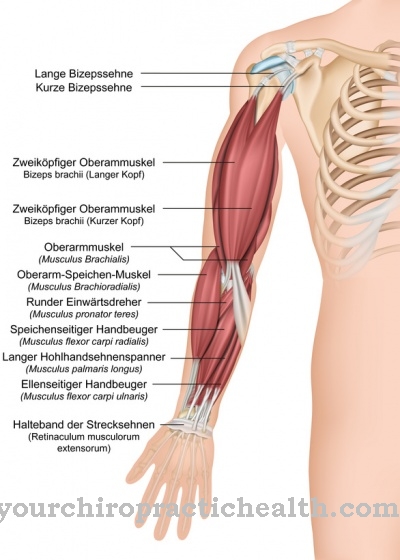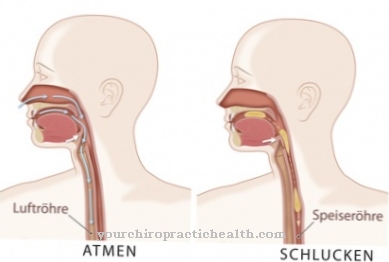This article looks at the Breathing depth. In addition to the definition of the term, it is on the one hand about the functions and benefits. On the other hand, it should be examined which diseases and complaints can occur in humans in connection with the depth of breath.
What is the depth of breath?

The depth of breath depends on various parameters, in particular on the relationship between tidal volume and breathing rate. Tidal volume is the amount of air that is taken in when you inhale. Under normal conditions it is 0.5 l at rest. With increased oxygen demand, e.g. through exertion, it can be increased significantly.
The respiratory rate is the number of breaths per unit of time and is usually measured per minute. The normal value for a healthy, adult person is 12-18 breaths per minute.
The respiratory minute volume can be determined as a product from both values. For example, 12 breaths per minute with a tidal volume of 0.5 l result in a minute volume of 6 l, which is sufficient for a healthy person to cover the oxygen demand at rest.
To compensate for increased demands, both the volume and the frequency can be increased. The one of the two sizes that predominates determines the breathing depth. If the frequency is increased more, the tidal volume decreases and one speaks of shallow breathing. Conversely, if the additional requirement is more likely to be covered by increasing the volume, we are dealing with deep or deepened breathing.
Function & task
The depth of breath is a decisive factor for the adequate supply of oxygen to the blood and the release of carbon dioxide into the lungs. This process is known as gas exchange.
When you breathe in, the air enters the throat through the mouth or nose and from there is passed on through the larynx, windpipe and bronchi. This part of the breathing system is only responsible for the conduction, heating and humidification of the breath.
The transfer, in which oxygen is released into the blood and CO2 is absorbed into the lungs, takes place exclusively in the alveoli, which are at the end of the airways. The basic requirement for this process to function properly is adequate ventilation in this area. If the breathing depth is reduced, this condition is not met, no or not enough oxygen-saturated air gets there and the time for the exchange is too short. The result is that not enough O2 can be absorbed into the blood and the need is not met. The air is then only moved back and forth in the airways without any benefit to the body.
Such a disorder leads to a chemical change in the composition of the blood, which is registered by receptors and reported to the respiratory center. From there an attempt is made to compensate for the deficit by increasing the minute volume. However, the situation can be exacerbated if the compensation is mainly carried out by increasing the frequency. The individual breaths become shorter and shorter, the tidal volume decreases and less and less air reaches the alveoli.
The situation is exactly the opposite when the additional oxygen requirement is mainly achieved by deepening breathing. The tidal volume increases, a lot of O2-saturated blood reaches the area where the gas exchange takes place and stays there long enough. This is also the reason why some breathing techniques take a break at the end of inhalation and exhalation: to lengthen the exchange phases.
You can find your medication here
➔ Medication for shortness of breath and lung problemsIllnesses & ailments
Diseases that affect the functioning of breathing can affect the lung tissue itself or surrounding structures. The respiratory diseases are classified according to various criteria. One factor is the duration of the illness, divided into acute and chronic lung diseases. Another criterion is based on the location of the disease. If the lung tissue is affected, one speaks of restrictive diseases, and obstructive ones if the airways are impaired. In the case of restrictive diseases, inhalation is initially restricted; in obstructive diseases, exhalation is initially restricted.
Typical restrictive diseases are pneumonia and pulmonary fibrosis. In pneumonia, the lung tissue is acutely inflamed by pathogens, its flexibility is reduced and inhalation is reduced. Pulmonary fibrosis develops over a long period of time as a result of inhaling harmful substances and then becomes chronic.The silicosis of miners and asbestosis of workers who have surrounded themselves a lot with the insulating material asbestos are known from earlier times. The consequences are the same as with pneumonia, but differ in the chronic course, with progressive aggravation.
A classic obstructive disease is chronic obstructive bronchitis (COPD). Recurring inflammation of the airways leads to a narrowing of the same due to the swelling of the walls of the bronchial mucous membrane and the increased production of mucus. Affected people mainly have problems with exhalation, which means that more stale air remains in the lungs than normally saturated air.
Another typical obstructive disease is bronchial asthma, an acute condition that occurs in attacks. Overreaction to certain stimuli leads to a spasm (cramp) of the bronchial muscles, which significantly restricts the cross-section of the bronchi.
Regardless of the cause, all diseases result in more or less severe shortness of breath (dyspnea). However, the strength of the shortness of breath can vary greatly depending on the severity of the disease. For example, severe asthma attacks can be life-threatening.
The cause of an impairment of the breathing depth can also be a disturbance of the breathing mechanics. During inhalation, the lungs follow the excursions of the chest due to their special construction. A restriction of mobility leads to an impairment of the breathing depth and, if the compensation no longer works sufficiently, also to shortness of breath. Typical diseases are ankylosing spondylitis, osteoporosis and other diseases that lead to a stiffening of the thoracic spine.













.jpg)

.jpg)
.jpg)











.jpg)